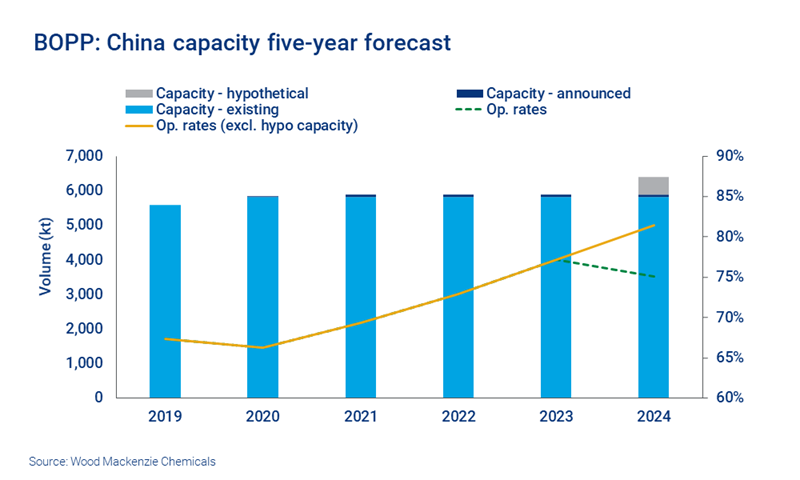Discuss your challenges with our solutions experts
How flexible packaging demand has given BOPP film a boost
Covid-19 has changed consumer habits and driven new demand
1 minute read
Demand for biaxially oriented polypropylene (BOPP) has grown 3.5% per annum over the last five years (to the end of 2019). The industry is worth around US$14 billion, supplying around 8.3 million tonnes last year. But what effect has a year of unprecedented change had on the outlook for BOPP?
This article draws on findings from our latest BOPP Film Global Supply Demand Report. Visit the store to find out more about the study, which includes growth forecasts for the next five years.
Slower demand in China had slowed global growth at the start of 2020
Chinese BOPP film demand has been unable to match the pace of new capacity added in China in recent years. Additional capacity has meant increased competition, excess product in the market and rising inventories.
Film demand growth slowed steeply in 2019, with some sources even reporting a slight decline in consumption. In the first half of last year, there was a noticeable reduction in operating rates – an apparent attempt to balance a well-oversupplied market.
As the world’s largest BOPP film market (accounting for almost half of global demand), China’s slowing demand growth has resulted in a slower global growth rate overall, in the last five years to the end of 2019.
The pandemic changed consumer habits
The world was caught by surprise in 2020, as the coronavirus pandemic rapidly shifted consumer habits. For BOPP market participants, this has inevitably meant new challenges, but for some it has also been a time of opportunity.
Most economies entered a deep recession in 2020 and saw their industrial output and manufacturing severely impacted. In most countries where industrial end-uses account for a significant share of the BOPP market, this led to slower-than-expected BOPP film demand growth, and in some instances even a contraction. Major BOPP film markets, such as China and India, experienced a negative impact to demand growth in 2020, with annual growth well below the average for the last five years.
Conversely, countries where food packaging is by far the largest demand end-use saw a boost in sales in 2020. Consumers stocked up as governments announced quarantines and stay-at-home measures. This boosted flexible packaging consumption – and thus BOPP film demand – in many markets, including Europe. As a mature market, we had expected moderate growth in this region, but the 2020 pandemic effect put annual demand growth at 2.7%, almost twice the 2019 growth rate.
We expect industrial activity will improve when the global economy begins to recover from the pandemic, which is likely to be in 2021. But we also see some potentially long-lasting changes to consumer spending trends. For instance, we anticipate that at-home food consumption and snacking could remain at higher levels than prior to the coronavirus outbreak for several more months, as more people permanently join the home-office trend. Because of this, flexible packaging will continue to be the key end-use sector for BOPP film. Transparent commodity film demand, which is often used in food packaging, is expected to drive future demand.
With sustainability firmly back on the agenda, new technology could pose a threat
The issue of recycling and sustainable packaging was temporarily put on hold in the early stages of the pandemic but has made a swift return to the agenda.
Sustainability concerns mean that BOPP film is more in favour than other polymers for many applications. Multinational brands are looking to film producers and converters to provide mono-material plastic packaging solutions to meet their sustainability commitments.
However, while there has been some switch over, we have yet to see material impact of this preference in the market. And a new contender may be entering the market – biaxially oriented polyethylene (BOPE) film. Up until now, polyethylene (PE) films, while typically cheaper than BOPP or BOPET films, were not matching performance expectations that biaxially oriented films achieve (with factors including stretch, mechanical, barrier and optical qualities). BOPE film is a step forward from common PE films. And now new BOPP/BOPE hybrid extrusion lines are available, which could pose a threat to BOPP film growth and potentially erode some of its market share.
Read the full report to find out more about hybrid lines, and BOPE’s potential impact on the BOPP film outlook.
There are positive signs for the future
There has been significant investment in installed capacity across the BOPP market since 2014. Global operating rates averaged 67% in 2019, and it comes as no surprise that, so far, less than one-third of the capacity added in the last five years has been announced through to 2024. However, we do not believe this will be case for long. As more supply is needed in fast-growing markets, namely China and India, by 2024, we expect demand growth will outpace that of supply.
For more insight on the global picture and region-by-region analysis, go to the store to access the full report.






